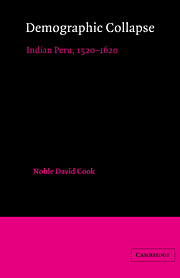Book contents
- Frontmatter
- Contents
- List of tables, figures, and maps
- Preface
- Introduction: The problem in perspective
- Part I Peru's preconquest population
- Part II Demographic collapse
- 8 First contact: north coast
- 9 Center of Spanish control: middle coast
- 10 Disease, earthquakes, and droughts: south coast
- 11 Intermediate area: northern highlands
- 12 Mining and population in the central sierra
- 13 The Indian heartland: southern highlands
- 14 An overview
- Abbreviations used in notes
- Notes
- Bibliography
- Index
- Titles in the series
11 - Intermediate area: northern highlands
Published online by Cambridge University Press: 02 December 2009
- Frontmatter
- Contents
- List of tables, figures, and maps
- Preface
- Introduction: The problem in perspective
- Part I Peru's preconquest population
- Part II Demographic collapse
- 8 First contact: north coast
- 9 Center of Spanish control: middle coast
- 10 Disease, earthquakes, and droughts: south coast
- 11 Intermediate area: northern highlands
- 12 Mining and population in the central sierra
- 13 The Indian heartland: southern highlands
- 14 An overview
- Abbreviations used in notes
- Notes
- Bibliography
- Index
- Titles in the series
Summary
The jurisdiction of the provinces of the city of Chachapoyas begins from the Rio de los Balsas … it is a rugged land of many rivers and is very fertile … beyond by the road is Leimebamba, and many other small pueblos. Near Leimebamba, travelling in the direction of Chachapoyas, is the province of Cajamarquilla del Collay … it is a fertile and productive land where much gold is taken. They harvest much wheat, potatoes and various fruits, although at present there are few Indians because many have died, and others have escaped to the Land of War they call Los Aucaes.
Antonio Vazquez de Espinosa, Compendia y description de las indias Occidentales, pp. 376–7The northern Peruvian Andes are distinct from the central and southern sections of the chain. The Andean mountains are both lower and narrower in the north than elsewhere. This fact accounts for the different ecological structure of the north and also helps explain the unique demographic development of the region. The highest point on the Ecuadorian border is only 3,726 meters. The passes between the coast and the upper Amazon basin are also lowest in the north. The cut of Porculla connecting the Olmos and Marañón valleys is a mere 2,144 meters in elevation. The transverse cuts in Figure 9 illustrate the low and broken nature of the Peruvian north. The whole of the northern sierra is also characterized by the Marañón River system. Running from south to north along the area, it divides the region into the more highland west, and the montaña to upper rain forests in the east.
- Type
- Chapter
- Information
- Demographic CollapseIndian Peru, 1520–1620, pp. 178 - 198Publisher: Cambridge University PressPrint publication year: 1982



